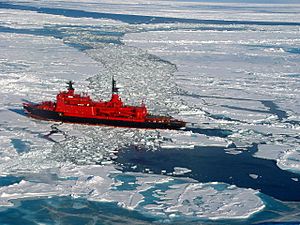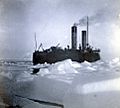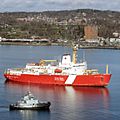Icebreaker facts for kids
An icebreaker is a special kind of ship or boat. It is built to travel through waters covered in ice. Icebreakers also create safe paths for other ships to follow. While we usually think of large ships, smaller icebreaking boats were once used on canals.
For a ship to be a true icebreaker, it needs three key things. First, it must have a very strong hull (the body of the ship). Second, its shape must be designed to clear ice. Third, it needs powerful engines to push through sea ice.
Icebreakers clear paths by pushing directly into the ice. Sea ice is not very strong when bent. So, the ice usually breaks easily as the ship moves forward. If the ice is very thick, an icebreaker can even drive its bow (front part) onto the ice. This uses the ship's heavy weight to break the ice below.
Broken ice can slow a ship down a lot. Because of this, icebreakers have a special hull design. This design helps push the broken ice around or under the ship. The parts that make the ship move, like propellers, are also at risk of damage. So, an icebreaker must be able to break ice and clear it safely.
Contents
How Icebreakers Work
Icebreakers are built to handle tough ice conditions. Their unique design allows them to operate where other ships cannot. They use their strong hulls and powerful engines to break through frozen waters.
When an icebreaker moves, it creates a channel. This channel allows other ships to pass through safely. This is very important for trade and travel in icy regions.
What Icebreakers Do
Today, most icebreakers help keep important trade routes open. These routes are in areas that have ice for part of the year or all the time. Merchant ships that visit these ports are often built to handle some ice. However, they are usually not strong enough to get through thick ice on their own.
If a ship gets stuck in ice, an icebreaker comes to help. It breaks the ice around the stuck ship. Then, it can open a safe path through the ice field. In very difficult ice conditions, the icebreaker can even tow (pull) weaker ships to safety.
Supporting Science and Research
Some icebreakers also play a big role in science. They help scientists explore the Arctic and Antarctic regions. These ships carry researchers and their equipment. They allow scientists to study the polar environments.
Protecting Offshore Operations
As offshore drilling happens more in the Arctic seas, icebreaking ships are needed. They deliver supplies and equipment to drilling sites. They also protect drillships and oil platforms from ice. This is called "ice management." It includes breaking large pieces of drifting ice into smaller ones. Icebreakers can also steer icebergs away from important structures.
Images for kids
-
Canadian and US coast guard icebreakers in the Arctic Ocean.
-
City Ice Boat No. 1 at the Delaware River. This paddle steamer was built in 1837.
-
A United States Coast Guard icebreaker in McMurdo Sound supporting Operation Deep Freeze.
See also
 In Spanish: Rompehielos para niños
In Spanish: Rompehielos para niños

















